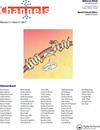MscL α螺旋的纳米力学性质:定向分子动力学研究
IF 3.2
3区 生物学
Q2 BIOCHEMISTRY & MOLECULAR BIOLOGY
引用次数: 21
摘要
机械敏感(MS)通道的门控是由响应双层张力的跨膜螺旋的运动和变形的分层级联驱动的。因此,确定单个跨膜螺旋的内在力学特性对于理解质谱通道门控机制的复杂性至关重要。我们使用恒力导向分子动力学(SMD)方法对结核分枝杆菌和大肠杆菌同源物中的MscL的所有螺旋进行单向拉力试验。利用这种方法,我们可以克服常用的等速SMD模拟所遇到的问题,例如螺旋在拉伸过程中的机械稳定性较低以及弹性性能对拉拔速率的高度依赖。我们估计MscL α-螺旋的杨氏模量在0.2到12.5 GPa之间变化,其中TM2螺旋最硬。我们还研究了水对衬孔TM1螺旋结构性能的影响。在没有水的情况下,这个螺旋结构表现出更僵硬的反应。通过监测氢键的数量,可以看出水在TM1螺旋延伸过程中起到了“润滑剂”(软化剂)的作用。这些数据揭示了MS通道疏水门控的另一个物理方面,特别是MscL。本文章由计算机程序翻译,如有差异,请以英文原文为准。
Nanomechanical properties of MscL α helices: A steered molecular dynamics study
ABSTRACT Gating of mechanosensitive (MS) channels is driven by a hierarchical cascade of movements and deformations of transmembrane helices in response to bilayer tension. Determining the intrinsic mechanical properties of the individual transmembrane helices is therefore central to understanding the intricacies of the gating mechanism of MS channels. We used a constant-force steered molecular dynamics (SMD) approach to perform unidirectional pulling tests on all the helices of MscL in M. tuberculosis and E. coli homologs. Using this method, we could overcome the issues encountered with the commonly used constant-velocity SMD simulations, such as low mechanical stability of the helix during stretching and high dependency of the elastic properties on the pulling rate. We estimated Young's moduli of the α-helices of MscL to vary between 0.2 and 12.5 GPa with TM2 helix being the stiffest. We also studied the effect of water on the properties of the pore-lining TM1 helix. In the absence of water, this helix exhibited a much stiffer response. By monitoring the number of hydrogen bonds, it appears that water acts like a ‘lubricant’ (softener) during TM1 helix elongation. These data shed light on another physical aspect underlying hydrophobic gating of MS channels, in particular MscL.
求助全文
通过发布文献求助,成功后即可免费获取论文全文。
去求助
来源期刊

Channels
生物-生化与分子生物学
CiteScore
5.90
自引率
0.00%
发文量
21
审稿时长
6-12 weeks
期刊介绍:
Channels is an open access journal for all aspects of ion channel research. The journal publishes high quality papers that shed new light on ion channel and ion transporter/exchanger function, structure, biophysics, pharmacology, and regulation in health and disease.
Channels welcomes interdisciplinary approaches that address ion channel physiology in areas such as neuroscience, cardiovascular sciences, cancer research, endocrinology, and gastroenterology. Our aim is to foster communication among the ion channel and transporter communities and facilitate the advancement of the field.
 求助内容:
求助内容: 应助结果提醒方式:
应助结果提醒方式:


